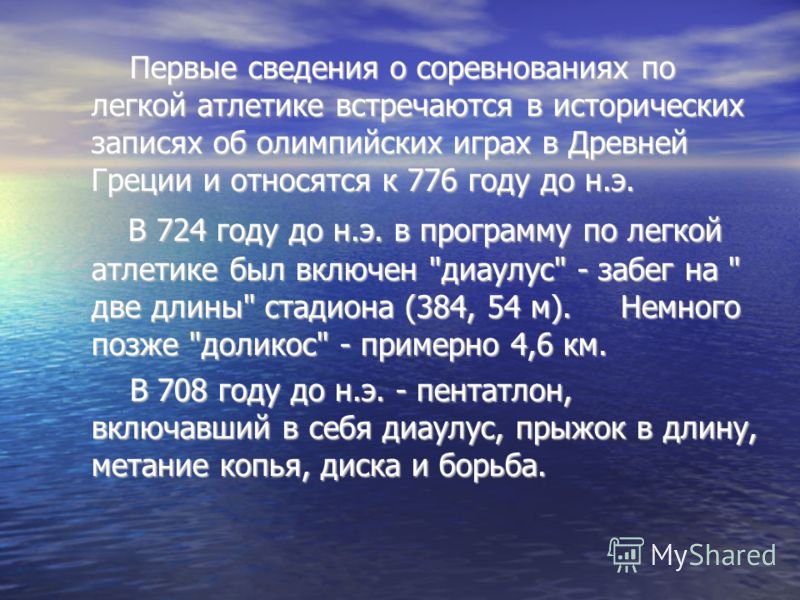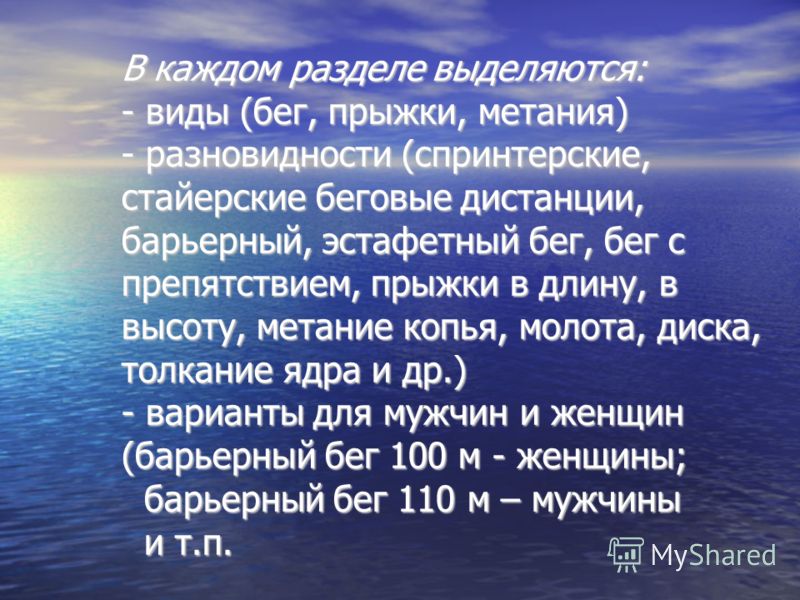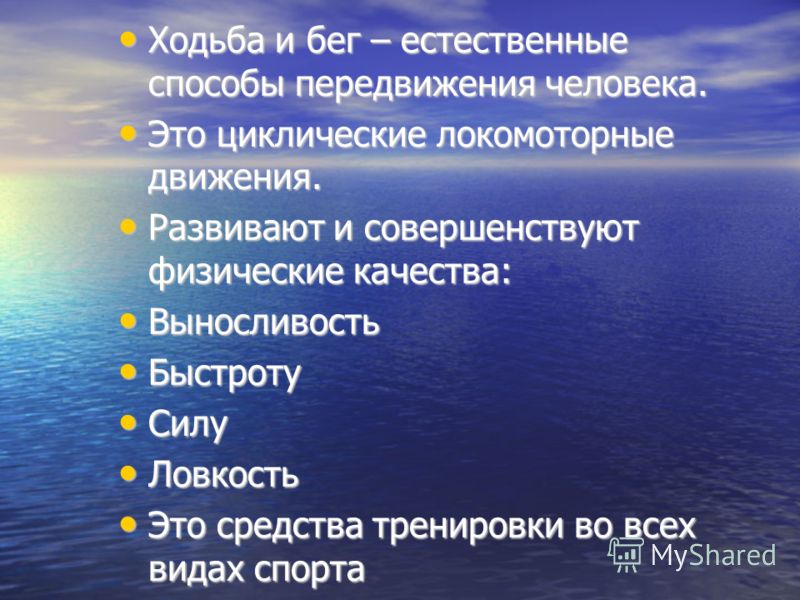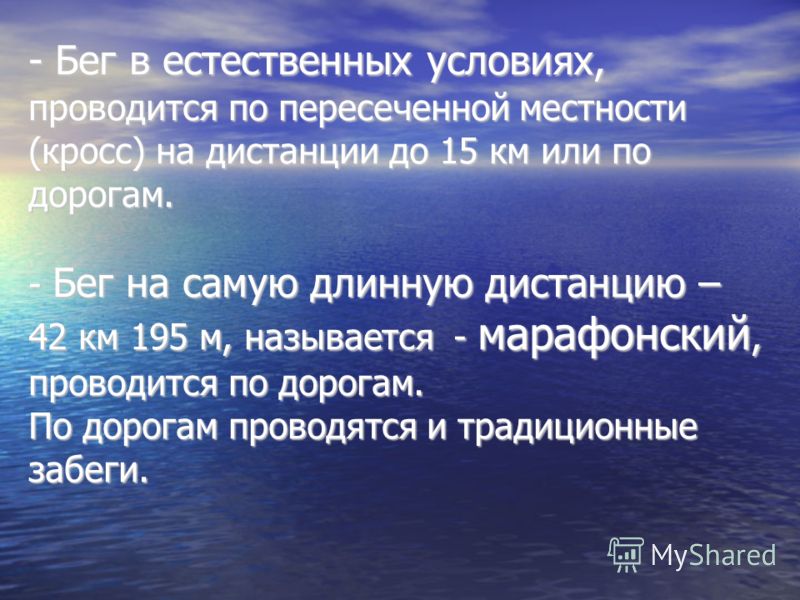The birth of athletics. A brief history of the development of athletics
The birth of athletics in Russia. Every kind athletics It has its own history, its triumphs and tragedies, its records, its names. The official birth date of athletics in Russia is considered to be 1888. That summer, a group of young people having a rest in the summer resort of Tyarlyovo near St. Petersburg created a runner's club, and on August 6 of the same year they held their first running competition. Money for the organization of the competition, for commemorative prizes was collected by subscription. The following year, the circle took the name "Society of Runners", and since 1893, the St. Petersburg Circle of Sports Lovers. Kruzhkovtsy started jogging classes in early spring on Petrovsky Island, and with the onset of summer in Tyarlyovo.
The competition program was supplemented in 1893. long jumps with a running start, from 1895 a shot put, high jumps, hurdles and hurdles (steeplechase). A bit later, cross-country and pole vaulting, discus and javelin competitions appear.
The program of the big sports festival, organized by the club in 1895, where about 10,000 spectators were present thanks to free admission, in addition to bicycle races, included running at different distances, long jumps from running, hurdling, throwing the ball and cast-iron core. The circle has become the center for the development of athletics in Russia. Here the first rules of the competition were developed, which received general recognition.
Russian victories: In a match in Kiev in 1965, the male team of the USSR team defeated American athletes for the first time (118: 112), and the female team of the USSR team was 20 points ahead. The next page - the eighth - was only four years later, again in Los Angeles, sports happiness at that time was on the side of American athletes - 195: 174. A year later, the old rivals met in Leningrad, our team won with a score of 200: 173. The first draw in the “giants” match was recorded in the tenth match (186: 186). The eleventh match of 1973 in Minsk brought an unexpected gap in points - 216: 163 in favor of the Soviet team.
Match of 1974 was held in Durham and the commentator of the ABC television companies said: “Soviet athletes won the traditional match - 192: 184. The guests world records were the decoration of the match. ” L. Bragin ran 3000m for 8: 52.74. In the 4x440 yards relay race, our runners set a new record - 3: 34.28 seconds. In 1975 in Kiev, the prizes of the thirteenth match of the USSR-USA were played. The score 225: 138 in favor of the USSR national team remains a record, it seems, to this day. In Washington in 1976 American athletes are losing again.
And again world records: L. Bragin - at 3000m -8: 27.12, in the triple jump he again became the hero of the match V. Sanaev. Arriving in 1977 in Sochi, American athletes suffered a twelfth defeat in fifteen matches. In 1978 at the stadium of the University of California, the Americans won with a score of 190: 177. But the seventeenth meeting in Leningrad again ended in a victory for the hosts (204: 178). In 1982 the venue was again the American continent and ended with a convincing victory for the USSR national team - 207: 167. During this match, an outstanding sprinter Karl Lewis showed his extra-class, having won the 100 meters with a new match record - 10.09 seconds. The last USSR-USA match took place in Tokyo in 1985. Soviet athletes were able to win the fifteenth victory in traditional matches. Since 1958 to 1985 regularly met the two strongest track and field teams of the planet - the USSR-USA. Sports fans, athletics fans of those years will not forget these matches. four.
End of work -
This topic belongs to the section:
Types and nature of athletics competitions (abstract)
Systematic athletics exercises develop strength, speed, endurance and other qualities that a person needs in ... In the system of physical education athletics occupies a dominant position ... In the program of the modern Olympic Games athletics is represented by 24 numbers for men and 14 for women. ...
If you need additional material on this topic, or you did not find what you were looking for, we recommend using the search on our database of works:
What we will do with the received material:
If this material turned out to be useful for you, you can save it to your page in social networks:
Athletics has a long history, originating in ancient times. - Athletics has a centuries-old history, originating in ancient times. - Archaeological finds - vases, medallions, coins, sculptures help to imagine how the ancient Greeks, and later the Romans held sports, which were called athletics. - Archaeological finds - vases, medallions, coins, sculptures help to imagine how the ancient Greeks, and later the Romans held sports, which were called athletics.
Ancient Greeks called all physical exercises athletics and divided them into "light" and "heavy" Ancient Greeks called physical exercises all athletics and divided them into "light" and "heavy"

To the easy they attributed exercises that develop - To the easy they attributed exercises that develop dexterity, speed, agility, quickness, endurance - this is running, jumping, endurance - this is running, jumping, throwing, archery, swimming. throwing, archery, swimming. -Fighting, fisticuffs and all those exercises that develop strength, the ancient Greeks called weightlifting. -Fighting, fisticuffs and all those exercises that develop strength, the ancient Greeks called weightlifting.

The first information about athletics competitions is found in historical records of the Olympic Games in Ancient Greece and dates back to 776 BC. The first information about athletics competitions is found in historical records of the Olympic Games in Ancient Greece and dates back to 776 BC. In 724 BC “diaulus” was included in the track and field program - a run for the “two lengths” of the stadium (384, 54 m). A little later, Dolikos - about 4.6 km. In 724 BC “diaulus” was included in the track and field program - a run for the “two lengths” of the stadium (384, 54 m). A little later, Dolikos - about 4.6 km. In 708 BC - pentathlon, which included the diaulus, long jump, javelin, discus throw and wrestling. In 708 BC - pentathlon, which included the diaulus, long jump, javelin, discus throw and wrestling.

In the last centuries BC The Olympic Games were attended mainly by professional athletes. In the last centuries BC The Olympic Games were attended mainly by professional athletes. This led to more frequent cases of fraud, dishonest methods. The games began to resemble the fierce contests of gladiators and lost their significance as a pan-Greek holiday. This led to more frequent cases of fraud, dishonest methods. The games began to resemble the fierce contests of gladiators and lost their significance as a pan-Greek holiday. The Olympic Games ceased to exist in connection with the loss of independence of Greece and its transition under the rule of Rome. The Olympic Games ceased to exist in connection with the loss of independence of Greece and its transition under the rule of Rome. In 393 A.D. under pressure from the clergy, the Roman emperor Theodosius I abolished the Olympic Games by special decree. In 393 A.D. under pressure from the clergy, the Roman emperor Theodosius I abolished the Olympic Games by special decree.


Given the importance of natural modes of movement, l / athletics is an integral part of the basic types of physical exercises in the physical education program of all educational institutions. Track and field exercises are relatively simple, understandable and accessible to any artist, easily dosed.


In each section, the following are distinguished: - types (running, jumping, throwing) - varieties (sprinting, stayer's running distances, barrier, relay relay, hurdling, long jump, high, throwing a spear, hammer, disk, shot put, etc. .) - options for men and women (100 m hurdles - women; 110 m hurdles - men, etc. In each section, the following are distinguished: - types (running, jumping, throwing) - varieties (sprinting, stayer's running distances, hurdle, relay race, obstacle course, long jump, high jump, javelin, hammer, discus throw, shot put, etc.) - options for men and women (hurdles 100 m - women; hurdles 110 m - men, etc.

Walking and running are natural ways of moving a person. Walking and running are natural ways of moving a person. These are cyclic locomotor movements. These are cyclic locomotor movements. Develop and improve physical qualities: Develop and improve physical qualities: Stamina Endurance Endurance Rapidity Rapidity Strength Strength Agility Agility These are training tools in all sports. These are training tools in all sports


Running has four varieties: 1. Smooth running (in a circle counterclockwise along the stadium treadmill for a certain distance). 2. Running with obstacles (artificial barriers from 5 to 10) - hurdling only for short distances from 60 to 400 m. - Running with obstacles for 1500 and 3000 m along the treadmill and one of the sectors where the water hole is located.

3. Relay race - a type of team race with the transfer of the relay stick. The distance is divided into separate stages according to the number of participants in each team. Stages can be: the same and mixed. Relays can be: - oncoming - along the circular path of the stadium - along the streets of the city.

Running in natural conditions, carried out on rough terrain (cross) at a distance of up to 15 km or on roads. - Running for the longest distance - 42 km 195 m, called - marathon, held on the roads. Traditional races are also held on the roads.

Sprint - short distances: - 60 m (manege) m mm m (long sprint). Running from a low start (using running pads)


Walking, running, jumping and throwing various - objects (spears, stones and other hunting tools) have been an important part of people's lives since ancient times. Naturally, they became the basis of competitions in strength, quickness, agility and endurance.
According to one of the ancient Greek legends, the first competitions were organized by Heracles in honor of the victory over Tsar Avgiy, and they were held in the run between the four brothers. According to legend, Hercules drew a place to start the run, then measured 600 feet. This distance became the length of the stadium and was called the stage (192.27 m).
The beginning of the formation and development of athletics exercises can be considered the Olympic Games of Ancient Greece, which were held in 776 BC. Such holidays of friendship and peace were held every four years. At the I Games, athletes competed only in one-stage running. Stage 2 running (dualos) was later included and
more - up to 24 stadia, i.e. endurance, and pentathlon competitions (pentathlon) have been held since the 18th Olympiad. It included: one-stage running, long jumps, discus and spear throwing, as well as wrestling.
Relay racing is no less ancient. The Greeks were extremely popular "lampaderiomas", or relay race with torches. The composition of the team included 40 participants.
The origins of the development of modern athletics originate not on the shores of the Mediterranean Sea, but on the British Isles. Already in the Manus K-Rips of the XII century. track and field competitions of Londoners are mentioned. Jogging usually took place on large roads between cities or on hippo droms. In 1770, the first result of an hour's run was recorded -
In the second half of the XIX century. In England, regular competitions were held among athletics. It is believed that the beginning of the history of modern athletics was laid by college students in Rugby in 1837 in competitions in running for a distance of about 2 km, after which such competitions began to be held in other educational institutions of England. Later, the short-distance running, obstacle course began to be included in the competition program, and from 1851 - long and high jumps with a run. In 1865, the London Athletic Club was founded. In the USA, an athletic club was organized in New York in 1868, a student sports union in 1879, and then athletics became widespread in American universities. This ensured in the following years (until 1952) the leading position of American athletes. But the real heyday of athletics occurred only after the revival of the Olympic movement.
To revive the modern Olympic Games, much effort has been made by both Greece itself and other countries. In 1894, an International Congress was held with the participation of representatives of sports organizations from 12 countries. The French public activist Pierre de Coubertin presented to Congress the organizational principles he developed for the Olympic movement. At the congress, a decision was made to hold the First Olympiad in 1896 in Athens, the birthplace of the ancient Olympic Games. The governing body of the Olympic movement was created - the International Olympic Committee (IOC). Since 1928, women enter the struggle for Olympic awards, and begins to develop intensively female light athletics. Although women have performed in athletics competitions before.
One of the most important factors in the development of athletics is its program at the Olympic Games. So, if at the First Olympics in Athens (1896) only 12 types of athletics were included in the men's program, then from the XIV Olympiad in London (1948) to the XXII Olympic Games in Moscow (1980) - already 24 species.
EASY ATHLETICS IN RUSSIA
Tyarlevo
EASY ATHLETICS IN RUSSIA
In our country, as in other countries, running, jumping and throwing have long been part of folk games, included in various festivals and festivities. However, the beginning of the development of athletics in Russia is considered to be 1888., when in a summer cottage near Petersburg– Tyarlevo–The first circle of sports fans was organized. At the beginning, competitions were held only for running at various distances, and later for other types of athletics: walking, jumping and throwing (since 1892). This club, organized by P.P. Moskvin, played a large role in the development of athletics in Russia. Following Petersburg, from 1901 to 1910, athletics began to be engaged in athletics in Riga, Odessa, Reval (Tallinn), Kiev, Samara, Astrakhan, Moscow, Stavropol, Kharkov, Tomsk and other cities. This made it possible to hold competitions not only within created circles and societies, but also between athletes of different cities.
The Russian Championship in Athletics was held in 1908 and was dedicated to the 20th anniversary of the creation of the Tyarlevsky circle of sports enthusiasts. In the future, the championships of Russia were held annually until 1916. In 1913 and 1914. Russian Olympics were held. The Athletics Federation was established in Russia in 1912.
After the revolution of 1917, competitions took place in 1918 in Moscow. In the future, athletics received great development, as it became the basis for training soldiers and the younger generation for military service in the ranks of the Red Army.
In 1920, Vsevobuch held a number of major competitions in Moscow, as well as the Siberian, Ural, North Caucasus and Central Asian Olympiads, in which athletics played a significant role. In 1921, the First All-Ukrainian Track and Field Athletics Competitions and the First Volga Olympiad were held. In 1922, the championship of the RSFSR was held for the first time in Moscow. This year was the beginning of the massive development of athletics among women.
With the formation of the Union of Soviet Socialist Republics -
USSR (1922) all-Union athletics competitions began to be held. In 1923, the First All-Union Festival of Physical Culture and All-Union Competitions for young athletes (under 17 years old) and the Red Army Championship were held. In the same year, the Pushkin - Leningrad (30 km) run was first held, which became traditional.
In the 30s, there was a further increase in the mass character and sportsmanship of Soviet athletes. This was facilitated by the introduction of
1931. The All-Union Physical Culture Complex of the TRP, which became the basis of the Soviet system of physical education of the population. He repeatedly improved, the number of steps for a wider involvement of students and working people of the country in systematic physical education and sports was increased, but invariably athletics exercises occupied a significant place in it. During
passing the standards of the TRP complex revealed more and more new names of talented athletes. The growth of the mass character and sportsmanship of our athletes was facilitated by the introduction in 1935 of the Union Classification of Physical Education of the USSR, as of 1941 - the Unified All-Union Sports Classification. Since 1936, the USSR Championships in Athletics have been regularly held, although in previous years some all-Union competitions were equated with the championships of the country.
For the best organization and leadership of the physical culture movement in the country in 1935-1936. trade union sports societies were created, and before that two of our leading sports societies, Dynamo and Spartak, were organized (in 1923). In these; many well-known athletes have grown up in societies, such as brothers G. and S. Znamensky, E. Vasiliev, A. Maslova, M. Shamanova, N. Dumbadze, R. Lyulko, N. Ozolin, whose results exceeded the best at that time achievements in Europe and the world.
During the Great Patriotic War, all work on physical culture and sport was aimed at protecting the homeland. Soviet athletes
including athletes, showed models of heroism and courage in the war.
In 1947, the USSR Athletics Federation became a member of the International Athletics Amateur Federation (IAAF). The Soviet Union joined the Olympic movement in 1951, and in 1952 in Helsinki
Soviet athletes first performed at the Olympics. The debut was successful. The champions of the Games were N. Romashkova (disc), G. Zybina (core), and silver medals were won by M. Golubichnaya (hurdles), A. Chudina (long jump, spear), Y. Lituev (400 m hurdles) )
At different times, the following became Olympic champions: N. V. Avilov, P. G. Bolotnikov, A. P. Bondarchuk, V. F. Borzov (twice), L. I. Bragin, V. N. Brumel , V. S. Golubnichy (twice), R. I. Klim, V. S. Krepkina, V. P. Kuts (twice), Y. V. Lusis, L. I. Lysenko, F. G. Melnik , E. A. Ozolina, N. A. Ponomareva (twice), I. N. Press (twice), T. N. Press (three times), V. V. Rudenkov, V. D. Saneev (three times), L V. Spirin, Yu.A. Tarmak, T. A. Tyshkevich, V. S. Tsybulenko, R. M. Shavlakadze, N. V. Chizhova, S. Masterkova, Yu. Borzakovsky, O. Kuzenkova, and others. European Champions: E. A. Arzhanov, V. M. Bogdanova, A. V. Ignatie c., M. L. Itkina, N. Z. Karakulov, K. Ya. Laptev (Mayugaya), N. G. Otkalenko, S. K. Popov, T. N. Sevryukova, E. I. Sechenova , N. V. Smirnitskaya, V. V. Kuznetsov, I. A. Ter - Ovanesyan, I. R. Turova, A. P. Chudina, T. S. Shchelkanova, L. M. Shcherbakov and others. Repeatedly improved the world , European and All-Union Records in Different Types of L. A.: E. E. Gorchakova, E. V. Gushchin, G. Ya. Klimov, G. I. Zybina, M. P. Krivonosov, Yu. N. Lituev, V I. Trusenev, Yu. Sedykh et al. Scientists and trainers V. I. Alekseev, V. M. Dyachkov, D. P. Ionov, G. V. Korobkov, D made a significant contribution to the theory and practice of Athletics. . P. Markov, N. G. Ozolin, V. V. Sadovsky, Z. P. Sinitsky, G. G. Suliev, L. S. Khomenkov, O. Ya. Grigalka, N. N. Denisov, G. I. Niki- forov, I.P. Sergeev, A.L. Fruktov, V.M. Yagodin, and others.
Introduction
Gymnastic exercises have a healing value. Classes are performed in the air, exercises affect all muscle groups: strengthen the motor apparatus, improve the activity of the respiratory organs, cardiovascular system. Thus, with the help of an athletics exercise, the tasks of harmonious, versatile physical development of a person are solved. Athletics is especially important for the formation of a growing organism, the physical education of the younger generation. Of great importance is the great applicability of athletics. Application is determined by how much the qualities and skills acquired with its help can be useful in life and in practical activities. Here athletics are unparalleled. Qualities - endurance, strength, speed, agility, flexibility, ability to overcome difficulties. Skills - running, jumping, throwing. Very widely used in labor and military affairs.
The educational value lies in the fact that track and field athletics form a character, temper a person’s will, teach him not to be afraid of difficulties, but boldly overcome them. Systematic training, preparation for competitions, achievement of sufficiently high sports results is not possible without observing the correct regimen, abstinence from alcoholic beverages and changes in nutrition. Light classes athletics in a team, participation in team competitions fosters a sense of collectivism, responsibility for the work received. Educational value - useful skills and knowledge are acquired from the field of construction and planning of sports classes, diet.
\u003e From the history of athletics
Even in ancient times, people needed to be able to run fast, cleverly overcome various obstacles, throw various kinds of shells. His hunting luck, and therefore his life, depended on man’s ability to catch and accurately hit prey, on the ability to be persistent and seasoned in the fight against the mysterious forces of nature. And so, primitive man was familiar with running, jumping and throwing - exercises that form the foundation of modern athletics. Archaeologists, digging out the sites of an ancient man, find a lot of eloquent evidence that already at the dawn of civilization, these skills played a huge role in everyday life. Of course, at that time about sport in its modern understanding and talk could not go. He was born much later. The homeland of sport can be considered Ancient Greece. The program of these competitions was mainly athletics. At first, their participants competed only in running at a distance equal to the length of the stadium (192 m 27 cm), which was called the "stage". (From here, in fact, the word “stadium” arose.) For more than half a century this type of running - the stadium - has remained the only type of competition at Hellenic Olympic holidays. At the Games of the 14th Olympiad (724 BC), prizes were first raffled in running at a distance equal to two stages. At the Games of the 15th Olympiad, endurance running appeared - from 7 to 25 stadiums. Already at that time, the participants in the Games specialized in certain types of competition programs. For example, long-distance runners, as a rule, very rarely started in short-distance running. But very often the same athlete performed at two short distances and often turned out to be the strongest on both at once. Competitions of runners in full combat gear were also held at the Olympic holidays. The athlete who won short distances, as well as in this type of competition, received the honorary title “triast”, that is, a three-time winner. Twice this honor was awarded to Leonidas from the island of Rhodes. Starting from the 16th Olympiad (708 BC), the program of the Games was enriched with a new kind - pentathlon. It included running, discus throwing, long jumps, javelin throwing and wrestling (as you can see, athletics form the basis in this all-around event). At that time, athletes performed long jump with special dumbbells in their hands. Then it was believed that this helps to strengthen the hand swing and to overcome a greater distance in flight. The spear and disc were thrown from a slight elevation. Moreover, the spear was held not just in the hand, but with the help of a loop from a leather belt, into which the thrower inserted fingers. Spear throwers at that time competed in throws at the accuracy of hitting the target, while discus throwers competed for range. What were the achievements of the participants of the Olympic competitions of antiquity? Unfortunately, it is rather difficult to compare their results with the results of modern athletes. The fact is that we received extremely contradictory information on this subject. But according to some sources, we can conclude that the winners of the ancient Olympics achieved good results even by modern standards. Thus, according to legend, the phlegium disco ball during training could throw a disc across the Alfei River (its width currently reaches 50 m). The winners of the competition were honored then very magnificent. They were crowned with olive wreaths, the branches of which were cut with a special golden knife from old sacred trees. When the champions returned home, they were met by crowds of joyful compatriots. Poets composed laudatory hymns in honor of the winners. The names of the champions were carved on stone slabs, and some of them even put monuments. It is because of this that their names reached us ...
The development of modern athletics began in the 30-40s. 19 century (the first competition was at Rugby College in England in 1837); in the 80-90s. in many countries amateur clubs, leagues, etc. were organized. The development of modern athletics is closely connected with the Olympic movement. Suffice it to say that the Olympic Games in Athens in 1896 was the first official international athletics competition. Since then, she has firmly taken a leading place in the program of all the Olympic Games. And it was the athlete who became the first Olympic champion. It was an American, James Connolly, who won the triple jump on April 5, 1896 with a score of 13 m 71 cm. However, not Connolly became the true hero of the First Olympics of our time. A few days later, marathon runners entered the fight. They ran 40 km along the very rocky road along which the Hellenic warrior-runner ran from the village of Marathon to Athens about 2500 years ago with the news of the Greek victory over the lane themselves. According to legend, the messenger ran into the city, not stopping on the road, and with an exclamation “We won!” Fell dead. In honor of the feat of this soldier, the run from the Marathon to Athens was included in the program of the Olympic Games. Subsequently, marathon running became one of the mandatory types of athletics. For Greece, the hostess of the First Olympics, the victory in this type of program was a matter of national pride and honor. Thousands of fans sighed in disappointment when a message came from the middle of the distance: there were no Greek runners among the leaders. But then the situation at a distance changed. The former leaders, unable to withstand the heat, got off, and the first to run into the stadium was the Greek Spyros Louis, a modest postman from the village of Maruzi. The king of Greece, together with the winner, ran the last lap, having left the royal box in a fit of feelings. Louis became the national hero of his country. In general, the Olympic debut of the “Queen of Sports” was very modest in Athens. Track and field athletes competed in only 12 types (compare: now the track and field program has 43 types). In total, less than a hundred athletes took to the start. For example, only five jumped in height. Much more participants gathered gymnastics and shooting competitions. Noteworthy is such an episode of the Olympic competitions. At the start of the distance of 100 m, most runners went in short white trousers and boots with short legs. And only one athlete - American Thomas Burke - was in his underpants and in lighter shoes, reminiscent of modern studs. If his rivals took a standing start, then Burke dropped to one knee and rested his hands on the ground. Viewers even laughed at this original. But what was their amazement when it was Burke who finished first. Since then, a low start has become common in sprinter competitions. The running technique in those days was not much like the honed movements of modern runners. Athletes ran constrained, intense. And only with time it became clear that speed is incompatible with tense muscles, that the freer the run, the higher the speed. Already at the II Olympics in Paris (1900), the American Francis Jervis significantly improved the Olympic record, breaking 100 m in 10.8 s. The achievements of the strongest athletes at that time grew quite quickly, not like now. So, Ellery Clark from the USA jumped to Athens in length by only 6 m 35 cm, and his compatriot Alvin Krenzlein became the best at the II Olympics in Paris with a result of 7 m 18 cm. The same awards were won in 5000 and 10000 m, in relay races 4X100 and 4X400 m, as well as decathlon. At the eight Olympics of our time, only men fought. But here in Amsterdam in 1928 women entered the athletics arenas for the first time. Their Olympic debut exceeded all expectations. In all five types of programs, women set world records.
